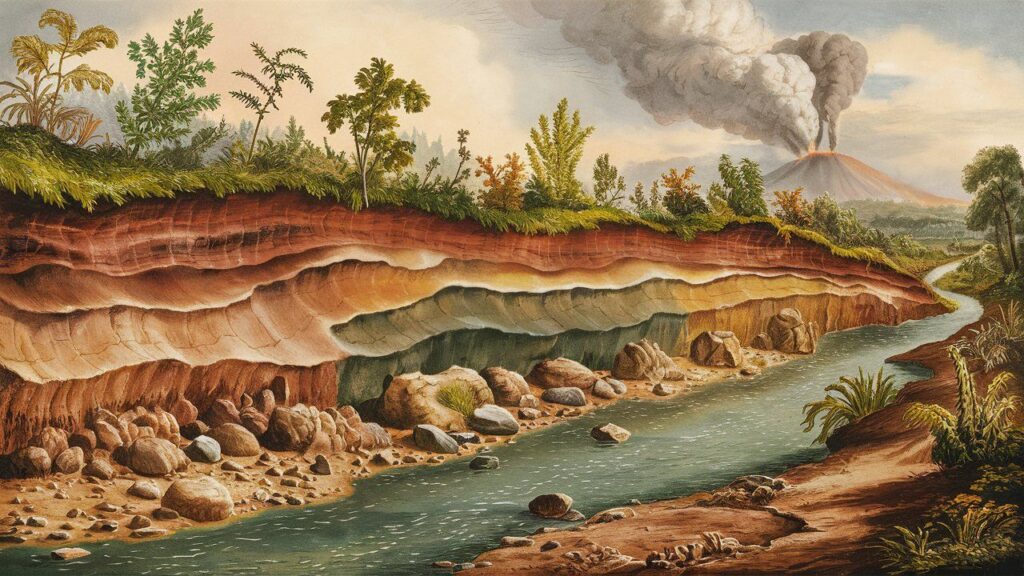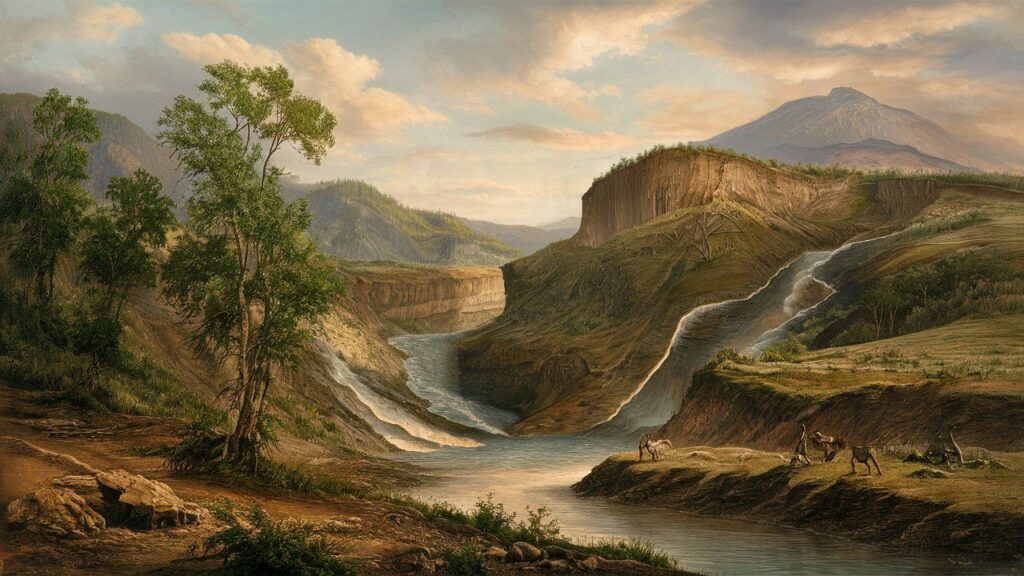Aggradation is caused by a combination of natural and human factors that lead to the accumulation of sediment in a particular area. Here’s a detailed exploration of what causes aggradation:

1. Climate Change
Climate change is one of the most significant factors influencing aggradation. Variations in temperature and precipitation patterns can affect the rate of erosion and sediment transport in a region. Here’s how:
- Dryer Climates: In arid or semi-arid regions, reduced vegetation cover leads to increased soil erosion. When vegetation that stabilizes the soil diminishes, more sediment is washed into rivers and streams. The reduced flow of water in drier conditions also means that rivers have less capacity to carry this sediment, leading to its deposition and an increase in land elevation.
- Wetter Climates: Conversely, increased rainfall can also lead to aggradation, especially in areas with loose, unconsolidated sediments. Heavy rains can cause landslides or wash large amounts of sediment into rivers. If the sediment load is too high for the river to transport, it deposits along the riverbed, raising the elevation.
2. Geological Activity
Geological events such as volcanic eruptions, earthquakes, and tectonic movements can trigger aggradation. Each of these activities contributes to the process in different ways:
- Volcanic Eruptions: Volcanic eruptions can release vast amounts of ash, lava, and debris into the surrounding environment. When these materials enter river systems, they can overwhelm the river’s capacity to carry the sediment, leading to deposition. This can result in the burial of existing river channels and the creation of new floodplains.
- Earthquakes and Faulting: Earthquakes can cause the ground to shift, altering the course of rivers and creating new channels. This disruption can lead to increased sedimentation as the river adjusts to the new landscape. Faulting can also uplift land, increasing the rate of erosion and the supply of sediment to rivers.
3. Changes in Land Use
Human activities play a crucial role in causing aggradation. Changes in land use, particularly those that involve deforestation, agriculture, and urbanization, can increase sediment supply to rivers:
- Deforestation: The removal of trees and vegetation destabilizes soil, making it more susceptible to erosion. Without roots to hold the soil in place, rainwater washes large amounts of sediment into nearby rivers. If the sediment load exceeds the river’s transport capacity, aggradation occurs.
- Agriculture: Farming activities, especially those that involve plowing and tilling, disturb the soil and increase erosion. Runoff from agricultural lands carries sediment into rivers, contributing to aggradation. Poor land management practices, such as overgrazing and improper irrigation, can exacerbate this effect.
- Urbanization: Construction and development activities often involve the removal of vegetation and the exposure of bare soil. Stormwater runoff from urban areas can carry significant amounts of sediment into rivers, leading to aggradation. Additionally, the construction of dams and reservoirs can trap sediment upstream, reducing the river’s capacity to transport sediment downstream and causing aggradation in the affected areas.
4. River Dynamics and Sediment Supply
The natural dynamics of rivers and their sediment supply can also cause aggradation:
- River Gradient: A river’s gradient (slope) plays a key role in determining its sediment-carrying capacity. When a river’s gradient decreases, its flow velocity reduces, causing sediment to settle and accumulate. This typically happens in areas where rivers enter floodplains, lakes, or the ocean.
- Base Level Changes: The base level of a river is the lowest point to which it can erode. If the base level rises due to factors like sea-level rise or the formation of a lake, the river’s velocity decreases, and sediment begins to deposit, leading to aggradation.
Conclusion
Aggradation is a complex process driven by a combination of climatic, geological, and human factors. Understanding these causes is essential for managing the effects of aggradation on landscapes, infrastructure, and ecosystems. As climate change and human activities continue to alter the natural environment, the study of aggradation becomes increasingly important for sustainable land and water management.
Aggradation is a process where land elevation increases due to the deposition of sediment, and it can be observed in various natural and human-influenced environments. Below are detailed examples of aggradation in action:
1. Volcanic Eruptions and River Aggradation
Volcanic eruptions are one of the most dramatic causes of aggradation. When a volcano erupts, it can release large quantities of ash, pumice, and other volcanic materials into the surrounding landscape. These materials often enter nearby river systems, overwhelming their ability to transport the sediment.
Example:
- Mount St. Helens, USA (1980 Eruption): The eruption of Mount St. Helens in Washington State caused massive landslides and deposited vast amounts of volcanic debris into the Toutle River. The sediment load was so great that the river could not transport it all downstream. As a result, the riverbed rose significantly, leading to the burial of the original channel. This aggradation forced the river to carve new pathways and created extensive new floodplains.
2. Aggradation Due to Climate-Induced Sediment Increase
Changes in climate can lead to significant aggradation, especially in regions where shifts in rainfall patterns alter erosion rates and sediment supply.
Example:
- The Sahel Region, Africa: The Sahel, a semi-arid region in Africa, has experienced significant aggradation due to changes in climate. During periods of drought, reduced vegetation cover led to increased soil erosion. The sediment washed into rivers during subsequent rainy seasons overwhelmed the rivers’ transport capacity. This resulted in the build-up of sediment on riverbeds, raising the land elevation and altering the hydrology of the region.

3. Human-Induced Aggradation Through Land Use Changes
Human activities such as deforestation, agriculture, and urbanization can greatly accelerate aggradation processes by increasing sediment supply to rivers and streams.
Example:
- Yellow River, China: The Yellow River, often called “China’s Sorrow,” is notorious for its high sediment load, largely due to deforestation and agricultural practices in the Loess Plateau. The plateau, composed of highly erodible silt, has been extensively farmed for centuries. Deforestation and poor land management practices have caused severe erosion, resulting in massive amounts of sediment being carried into the river. The river’s capacity to transport this sediment is limited, leading to significant aggradation. Over time, the riverbed has risen above the surrounding plains, requiring the construction of levees to prevent flooding. However, these levees occasionally fail, causing catastrophic floods.
4. Aggradation in Tectonically Active Regions
In tectonically active areas, earthquakes and faulting can disrupt river systems, leading to rapid aggradation.
Example:
- Indus River, Pakistan: In the tectonically active region of northern Pakistan, the Indus River has experienced significant aggradation due to a combination of tectonic uplift and increased sediment supply from landslides triggered by earthquakes. The 2005 Kashmir earthquake, for example, caused massive landslides that dumped large amounts of sediment into the Indus River and its tributaries. The sudden increase in sediment overwhelmed the river’s transport capacity, leading to the deposition of material and the raising of the riverbed.
5. River Gradient Changes Leading to Aggradation
Changes in a river’s gradient can also cause aggradation, especially when a river enters a low-gradient area, such as a floodplain or delta.
Example:
- Mississippi River Delta, USA: The Mississippi River Delta is an example of aggradation caused by a decrease in river gradient as the river approaches the Gulf of Mexico. As the river’s velocity slows, it deposits sediment, gradually building up the delta over thousands of years. This process has created extensive wetlands and landforms in the region. However, human activities such as the construction of levees and canals have disrupted this natural aggradation, leading to issues like land subsidence and coastal erosion.
6. Aggradation in Glacial Environments
In glacial regions, the melting of glaciers can lead to aggradation as large amounts of sediment are released into rivers.
Example:
- Kaskawulsh Glacier, Canada: The Kaskawulsh Glacier in the Yukon Territory has been retreating due to climate change, releasing vast amounts of sediment into the Slims River. The increased sediment load has led to aggradation along the riverbed, raising the land elevation and altering the river’s course. In 2016, the glacier’s retreat even caused a phenomenon known as “river piracy,” where the Slims River was diverted into another river system due to aggradation and changing water flow dynamics.
Conclusion
Aggradation is a widespread process that occurs in various environments, from volcanic regions to tectonically active areas, and from human-altered landscapes to glacial terrains. Understanding these examples of aggradation helps illustrate how sediment deposition shapes the Earth’s surface, influencing river dynamics, landscape evolution, and even human settlements.
Aggradation, the process of land elevation increase due to sediment deposition, has significant impacts on both natural environments and human activities. The effects of aggradation can be beneficial or detrimental, depending on the context and scale. Here is a comprehensive overview of the impacts of aggradation:
1. Positive Impacts of Aggradation
a. Creation of Fertile Floodplains
Aggradation can lead to the formation of fertile floodplains, which are beneficial for agriculture. As rivers deposit nutrient-rich sediments, these areas become highly productive for farming.
- Example: The Nile Delta in Egypt is an example where aggradation has created fertile land, supporting agriculture for thousands of years. The regular deposition of silt from the Nile River has enriched the soil, making it one of the most fertile regions in the world.
b. Formation of Natural Levees
Natural levees are elevated ridges that form along the edges of rivers due to the deposition of coarser sediments during floods. These levees can help protect adjacent lands from flooding.
- Example: Along the Mississippi River, natural levees have formed through repeated flooding events. These levees provide some level of protection against moderate floods, reducing the risk of damage to nearby communities and farmlands.
c. Habitat Creation
Aggradation can create new habitats for various plant and animal species. The formation of wetlands, deltas, and new river channels can support diverse ecosystems.
- Example: The Sundarbans delta in India and Bangladesh, formed through aggradation, is a vast wetland area that supports a unique ecosystem, including the endangered Bengal tiger, numerous fish species, and diverse bird populations.

2. Negative Impacts of Aggradation
a. Increased Flood Risk
One of the most significant negative impacts of aggradation is the increased risk of flooding. As sediment accumulates, riverbeds rise, reducing the capacity of the river to carry water. This can cause rivers to overflow their banks more frequently, leading to more severe and frequent floods.
- Example: The Yellow River in China is notorious for its history of catastrophic floods, largely due to aggradation. The riverbed has risen so much over centuries that the river now flows above the surrounding plains, making it prone to devastating floods when the levees fail.
b. Disruption of River Navigation
Aggradation can raise riverbeds and create sandbars, making navigation difficult for boats and ships. This can have economic implications, especially in regions where rivers are important transportation routes.
- Example: In the Brahmaputra River in India and Bangladesh, aggradation has led to the formation of numerous sandbars, making navigation hazardous. This has affected trade and transportation, particularly during the dry season when water levels are low.
c. Alteration of River Channels
Aggradation can lead to the burial of old river channels and the creation of new ones. This can disrupt ecosystems, human settlements, and infrastructure.
- Example: In the Indus River Basin, aggradation has caused significant changes in river channels, leading to the abandonment of old agricultural lands and the formation of new floodplains. This has displaced communities and disrupted traditional farming practices.
d. Sedimentation of Reservoirs and Dams
Aggradation can reduce the storage capacity of reservoirs and dams by depositing sediment at the bottom. This not only reduces the effectiveness of these structures for water storage and flood control but also shortens their operational lifespan.
- Example: The Sanmenxia Dam on the Yellow River in China has experienced significant sedimentation since its construction. The accumulation of sediment has reduced the reservoir’s capacity, diminishing its effectiveness for flood control and hydroelectric power generation.
e. Disruption of Aquatic Ecosystems
Aggradation can negatively impact aquatic ecosystems by altering water flow patterns, reducing habitat availability, and increasing turbidity. This can affect fish populations and other aquatic life.
- Example: In the Ganges River, aggradation has led to increased sedimentation, which has disrupted fish breeding grounds and reduced water quality. This has affected local fisheries and biodiversity.
f. Infrastructure Damage
Aggradation can cause damage to infrastructure such as bridges, roads, and irrigation systems. As riverbeds rise, these structures may become more vulnerable to erosion, flooding, or burial by sediment.
- Example: In Nepal, aggradation in the Koshi River has repeatedly damaged bridges and roads, cutting off access to remote areas and necessitating costly repairs and reconstruction efforts.
3. Long-Term Environmental Impacts
a. Landform Evolution
Over time, aggradation can lead to significant changes in landscape and landform development. Deltas, floodplains, and alluvial fans are all products of long-term aggradation processes. While these landforms can be beneficial, they can also alter regional hydrology and disrupt natural processes.
- Example: The Mississippi River Delta has evolved over thousands of years through aggradation. While it has created vast wetlands and fertile lands, the reduction of sediment supply due to human activities has led to land subsidence and coastal erosion.
b. Loss of Wetlands
In some cases, aggradation can lead to the loss of wetlands as sediment builds up and converts these areas into dry land. This can result in a loss of biodiversity and disruption of the ecosystem services that wetlands provide.
- Example: In the Everglades in Florida, changes in water flow and sedimentation patterns due to human activities have led to the loss of wetland areas, threatening the region’s biodiversity and water quality.
Conclusion
Aggradation has far-reaching impacts on both natural and human systems. While it can create fertile lands, natural levees, and new habitats, it also poses significant challenges such as increased flood risk, disruption of navigation, alteration of river channels, and damage to infrastructure. Managing the impacts of aggradation requires a comprehensive understanding of the process and careful planning to mitigate its negative effects while maximizing its benefits.
Important Point
NO. | Important Points |
1. | |
2. | |
3. | |
4. |
FAQs of Aggradation
What is aggradation?
Aggradation is the geological process of increasing land elevation due to the deposition of sediment. This occurs when the amount of sediment supplied to an area exceeds the system’s capacity to transport it away, leading to the buildup of material on the land surface.
What causes aggradation?
Aggradation is caused by various factors, including:
Climate Change: Changes in precipitation and vegetation can alter erosion rates and sediment transport.
Geological Activity: Volcanic eruptions, earthquakes, and tectonic shifts can introduce large amounts of sediment into river systems.
Land Use Changes: Human activities such as deforestation, agriculture, and urbanization increase soil erosion and sediment deposition in rivers.
How does climate change influence aggradation?
Climate change can affect aggradation by altering the rate of sediment production and transport. For example, in drier climates, reduced vegetation cover can lead to increased erosion, sending more sediment into rivers. In wetter climates, enhanced sediment transport capacity may reduce aggradation.
Can human activities lead to aggradation?
Yes, human activities such as deforestation, farming, and urban development can significantly contribute to aggradation. By removing vegetation that stabilizes soil, these activities increase erosion, leading to higher sediment loads in rivers and subsequent deposition.
What are some examples of aggradation in nature?
Volcanic Eruptions: Eruptions can dump vast amounts of ash and debris into rivers, causing the riverbed to rise as the sediment accumulates.
Climate-Induced Sediment Increase: Changes in climate that reduce vegetation can lead to increased erosion, resulting in sediment buildup in rivers and altered landscapes.
What are the positive impacts of aggradation?
Aggradation can create fertile floodplains, which are beneficial for agriculture. It can also lead to the formation of natural levees, which help protect surrounding areas from floods.
What are the negative impacts of aggradation?
Negative impacts of aggradation include increased flood risk due to the elevated riverbeds, disruption of ecosystems, and burial of old river channels, which can affect both natural habitats and human infrastructure.
How can the impacts of aggradation be managed?
Managing aggradation requires a combination of strategies, including:
Monitoring sediment loads and river dynamics.
Implementing land-use practices that reduce erosion.
Designing infrastructure that can accommodate changes in river channels.
Can aggradation be prevented?
While it’s difficult to prevent aggradation entirely, its impacts can be mitigated through careful land management, reforestation, and controlling sediment supply in river systems.
How does aggradation affect river navigation?
Aggradation can disrupt river navigation by raising riverbeds and creating sandbars, making it difficult for boats and ships to pass. This can have economic implications, especially in regions where rivers are vital transportation routes.
